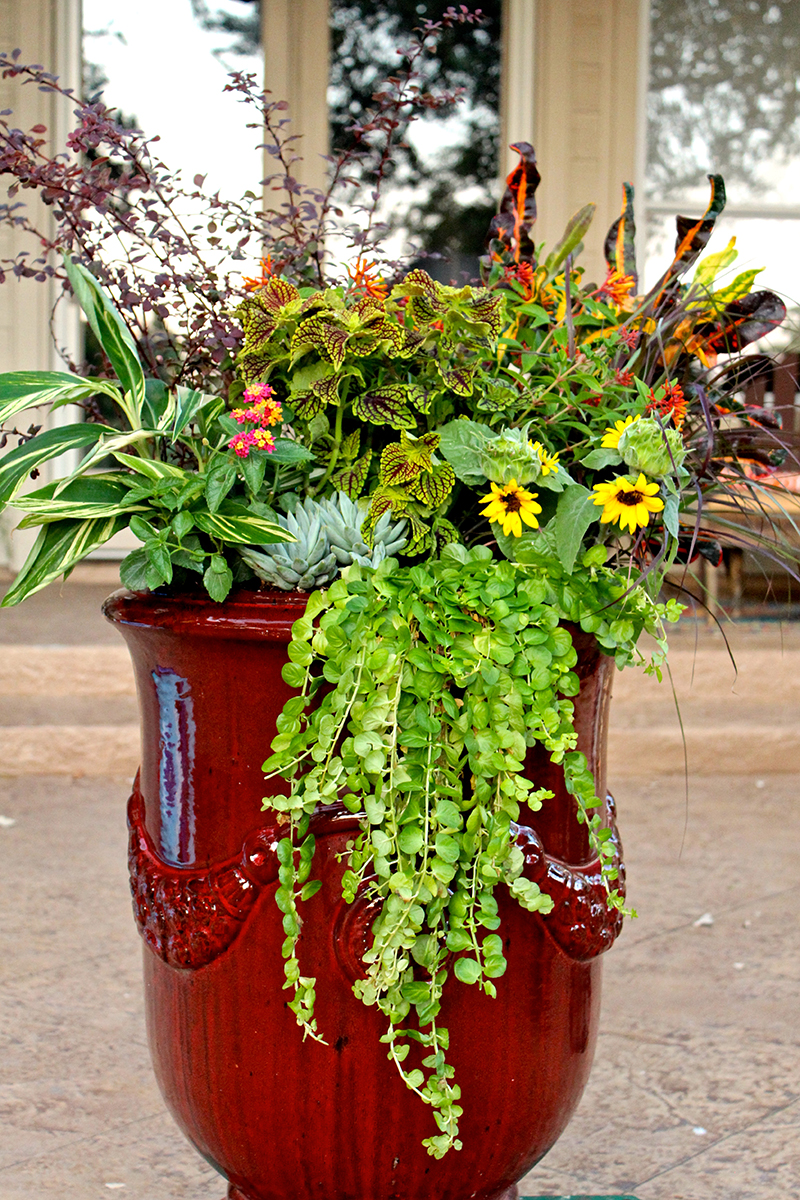
About this time of year, even the toughest Central Texas gardens and gardeners start to melt a little. With May rains but a distant memory, the unrelenting heat is taking its toll.
A quick and simple way to re-energize yourself and your garden for the slow journey into fall, consider refreshing your container plantings. If you have a nice pot with crispy inhabitants, now is the perfect time to start over. A fresh set of plants can provide a beautiful backdrop until the first frost.
Since the cooler temperatures of true fall won’t show themselves for a while, containers planted now still need to include plants that tolerate warm temperatures. Focusing on plants with new seasonal colors enables us to imagine that our respite awaits around the corner.
Designing a great container takes a little knowledge, some basic planning and a dash of creativity.
And pots aren’t just for patios anymore. Out in the landscape, containers create focal points, bring height or add shallow interest to existing landscape beds. In addition to creating conversation pieces with your plants, you can make use of things lying around in your attic or garage to create whimsical containers. A coat of paint in the right pop of color on a stock tank, or a simple plastic liner with a few holes placed into an old wooden box can transform your stuff into a welcome addition in your house or your garden.
Successful planting
As you pick your palette of plants, consider enhancing your creation with a varied selection of shapes, colors and textures. These contrasts will help your plants stand out. Your design can be symmetrical – balanced evenly all the way around, or asymmetrical, with unique plants extending to different distances on the sides or down the container. To achieve repetition and make your planter cohesive, you don’t have to duplicate the same plants around the container – just use plants with a similar color or texture.
Make sure you choose plants with the same sun and water needs so you aren’t over or under-watering any of your plants. Plants that appreciate the relief of a shady spot don’t fare well when combined with sun lovers. Most succulents and grasses make good partners since neither of them requires a lot of water and they both appreciate the sun. Adding a little mulch to your containers helps keep the soil cooler and lessens evaporation.
To keep your container plants thriving, it’s important to start with a good container soil that will allow drainage. Don’t use a pot without a hole in the bottom – this is the most common mistake in container gardening and can spell doom for your plants.
One tip for use in over-sized containers is to fill up the bottom with some alternate material if the plants you install in the planter don’t need all the root space of the container. You can fill the pot’s bottom with a variety of materials so not as much potting soil is needed. Make sure to use materials that won’t break down or decompose.
While there isn’t a formula to determine how many plants you should place in a container, it’s important to remember that your plants will grow. Consider carefully how they will mature – will they get taller, wider or trail and will they have enough room a month or two from now? You can plant things that may outgrow your pot after the season is over; then you can move them into your landscape and add new plants to the pot for the next season.
For containers that will hold more than one pretty plant, remember to include thrillers, spillers, and fillers. What are thrillers, spillers and fillers? That’s the recipe for making beautiful pots of plants – place a tall focal point (thriller) in the middle or the back of the container to rise up above the other plants and make an impact. Then place smaller plants (fillers) with contrasting or coordinating colors around the tall plant. Then finish the project with trailing plants around the inside perimeter of the pot to cascade down over the sides (spillers).
A good organic fertilizer ensures that your plants remain healthy, even as some of the nutrients leach from the soil through watering. Products like seaweed, fish emulsion or Hasta Grow are good organic choices.
Local nurseries, books, garden magazines and online resources like Pinterest and Houzz are brimming with beautiful container ideas and DIY information you can use to transform your garden containers.
Local Landscape Designer and Garden Coach Diana Kirby provides landscaping tips on Facebook at Diana’s Designs, at www.dianasdesignsaustin.com and she writes a garden blog at www.dianasdesignsaustin.com .

